-
Posts
348 -
Joined
-
Last visited
-
Days Won
1
Content Type
Profiles
Forums
Store
Gallery
Events
Local Fish Stores
FAQ
Blogs
Downloads
Posts posted by hammondegge
-
-
pretty neat concept. What is the flow rate going through the refugium? Do you think it might be too fast if it is the only return from the sump?
the return is split between the sump and the fuge with the majority of flow directed to the sump
yes Ace, i really dig it.
thanks nate....for all your help along the way angel3.gif ...i
-
"
You mention switching ballasts? Are 250w DE the same length as 150ws? I thought they were a larger bulb altogether.
i dont really know. the 150 is the only DE that i have owned. all other set-ups were SE and ballasts are easily changeable. if the bulbs are different sizes i imagine you could switch out the mounts if there is enough space in your fixture. but if the fixture is a nice one probably better off selling and replacing it.
-
This was an interesting design project so i will share it with you. Nate has a 55 gallon on an unusually narrow stand. i think the depth was around 10 inches. It has a brace in the center at back and about 21" of height in the cabinet but the door opening restricted sump height to around 15".
This is a two piece sump/refugium designed to maximize water volume, allow enough room for an in sump, or hang on sump, skimmer, and provide a large refugium to grow pods for his Mandarin.
We decided not to alter the stand and install from the back. therefor we must work around the centerbrace at back.
this is what we got
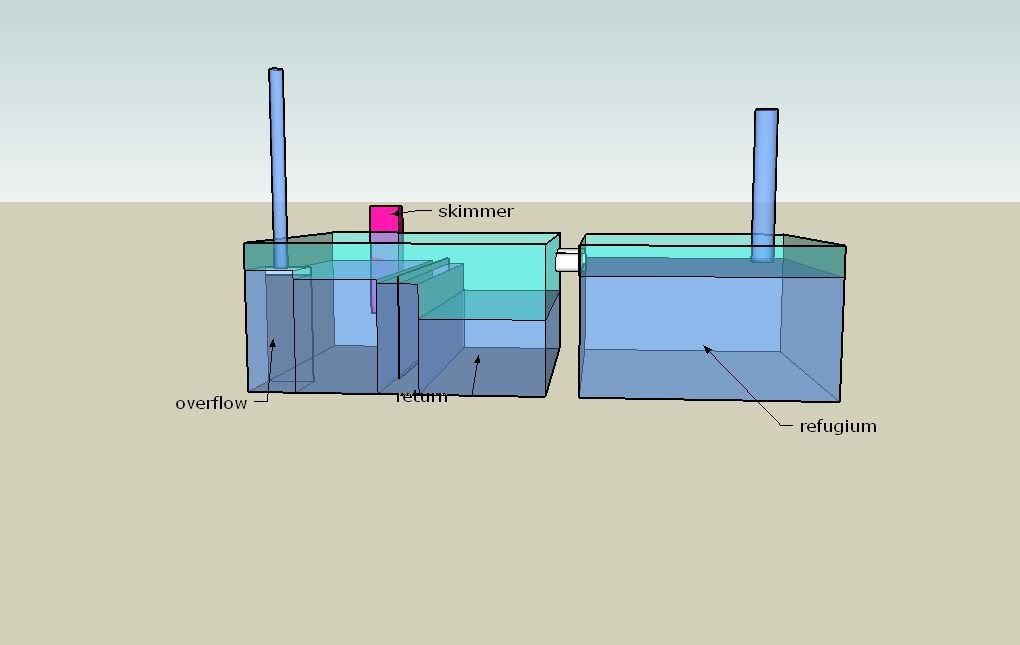
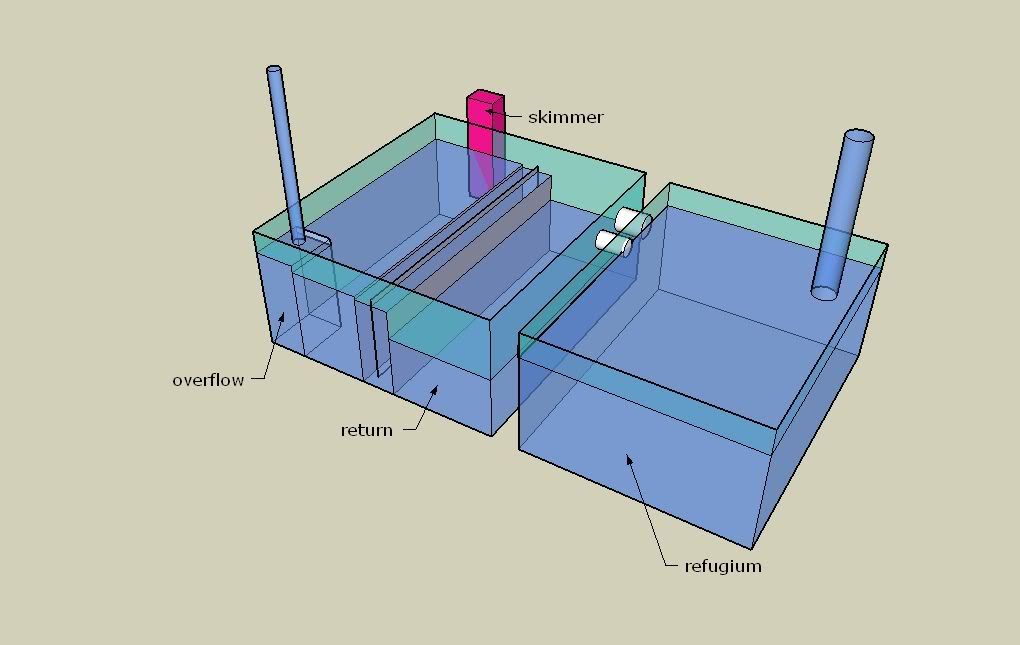
here is the water test.
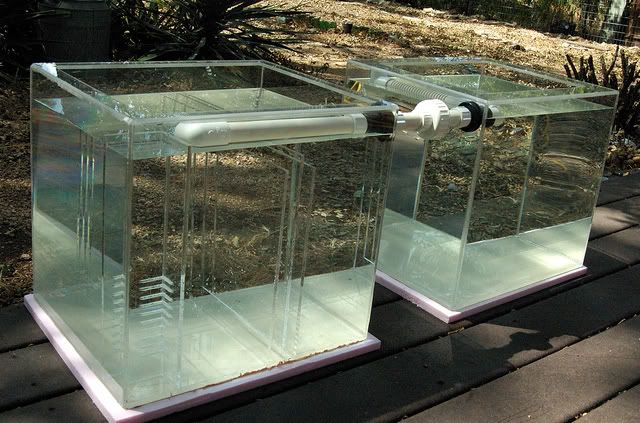
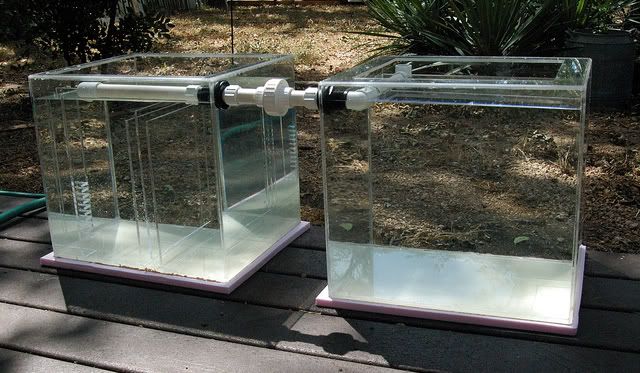

a detail of the refugium return and overflow combo.
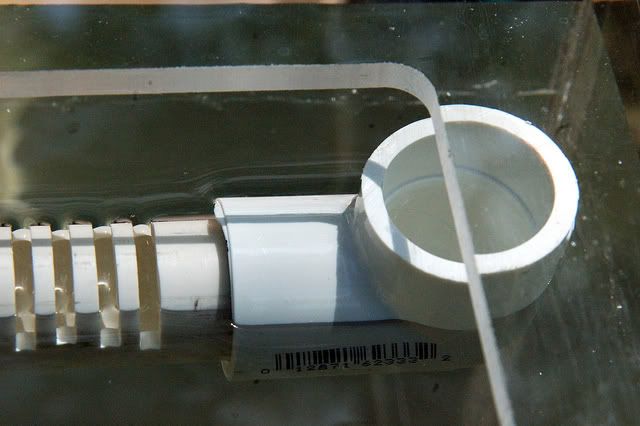
and installed. I still can't believe it fit.
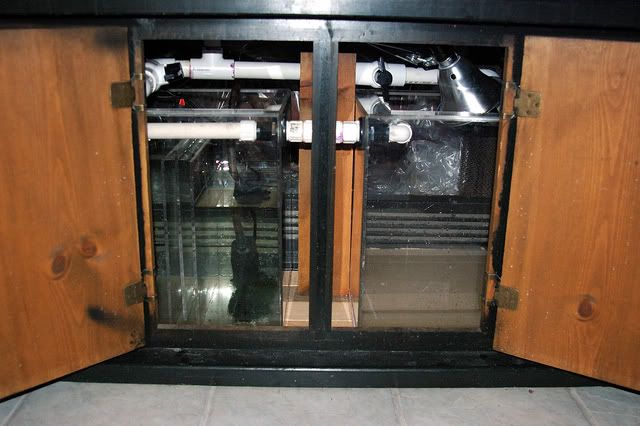
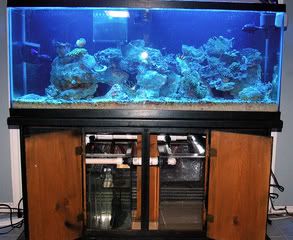
I believe we added about 20-25 gallons of water to this system.
-
you're welcome. good to meet you too anthony.
-
you are welcome.
i am all out for a while
-
hey mike, you should be able to grow sps well in the upper third of your tank with the lights that you have, but think your best move would be to switch out the 150 ballasts for 250 ballasts. i have 150w de's over my 55 and it works great, good growth and color for sps, but this is a shallow system and i only need the lights to penetrate about 10 inches of water. if you choose to stay with the 150's you might try the Phoenix 14k bulbs they are really bright with good color.
i think that adding a 400 to a dual 250 setup works a lot better than adding a 250 to a dual 150, as with the latter you have lights that are not fully penetrating the tank and your lighting may be unbalanced. you will benefit from adding more light no matter how you do it. some might be more effecient than others. for example, a dual 250w setup may give you the same or better results as the 150,250,150 system. not to mention heat issues. IMO.
-
i have one of those too. you can look at it when you come to get the caulerpa prolifera. you have a pm.
robert
-
got some
-
Gabriel,
I'll be interested to know how the airstone works for you. After reading the links that Robert posted about pH, I wondered why an airstone in the sump isn't more standard practice to help optomize CO2.
ej
to increase disolved oxygen levels relative to CO2.... it is working some for me. you would think that the skimmer would do all of this that is possible but it doesnt always.
-
aquadome has them on the shelf. i dont think they are worth the $20 that they cost. best to grow your own in your sump. IMO
-
sure apedroza and seahorse. send me pm's for time and directions.
-
right now it is only calcium, alk, ph, and phosphate for me.
i think the helpfulness of the testing changes as the tank matures and the inhabitants change. now i have a lot of corals that are growing fast in a relatively small volume of water ~ 75gal. i also have a heavy fish load. as the mass of coral changes my calcuim consumption increases (hopefully). ph and alk are important for me to keep my calcium high.
i dont check Am, nitrite, nitrate unless something looks wrong. the corals are real good barometers for any changes that happen in the tank. if something looks odd then i will test nitrate. it has been 0 for a long time but there was a time in a smaller tank with a crappier skimmer that i would see an increase.
since i put a phosphate reactor on the system i rarely test for phosphate anymore.
of course i test salinity when mixing salt and for water changes. a water top-off almost eliminates the need to test the tank. monthly is fine for me. the refractometer is a good purchase.
I dose a homemade 2 part with a medical peristaltic pump, and put Kalk in the top-off water to support higher PH. calcium stays around 450, ph ranges from 7.8 to 8.1 and alk tends to climb ( i havnt figured this out yet) but i try to keep it around 11dkh. i add magnesium as needed, well there is another test. i test magnesium level every few weeks and adjust it then with whatever magnesium potion that is handy.
principally i believe that a tank benefits from heavy feedings, so i put a lot of food in (homemade combination of foods suitable for corals fish, and inverts). with a lot of rock, a sandbed, a lot of flow (3500gph in a 55gal), a good oversized skimmer, and inhabitants in enough variety and numbers to eat everything, i think a strong and stable ecosystem is built that keeps the tank balanced. i think my tank would consume a dead fish pretty fast with no effect to the am, no3, no4 balance.
-
Randy Holmes-FarleyThe pH of marine aquarium water is intimately tied to the amount of carbon dioxide dissolved in the water. It is also tied to the alkalinity. In fact, if water is fully aerated (that is, it is in full equilibrium with normal air) then the pH is exactly determined by the carbonate alkalinity The higher the alkalinity, the higher the pH. Figure 1 shows this relationship for seawater equilibrated with normal air (350 ppm carbon dioxide), and equilibrated with air having extra carbon dioxide as might be present in a home (1000 ppm). Clearly, the pH is lower at any given alkalinity when the carbon dioxide is raised. It is this excess carbon dioxide that leads to most low pH problems for reef aquarists.sounds like your problem andrew. perhaps an airstone.
-
in my efforts to understand this better i came across these two excellent articles.
Low PH
http://www.reefkeeping.com/issues/2004-09/...9/rhf/index.php
High PH
http://www.reefkeeping.com/issues/2005-03/...3/rhf/index.php
and i will throw in this one on alk/calcium balance for comic relief
-
ej - that is a text book worth of stuff. i think you are spot on with what you mentioned though. i would like to understand more of the contributing factors too. i have found plenty of articles on alk and calcium with ph a secondary concern, not so much on the many reasons that ph moves around. alkalinity is essentially a measure of waters ability to buffer ph, right? and the right balance should be maintained between alk and calc. so maybe that is why the emphasis is not on ph.
-
i will have to watch it then with the kalk. does calcium hydroxide (kalk/lime) have a lesser effect on alk then sodium bicarbonate (baking soda) or calcium carbonate?
-
kalk will raise calcium and ph. maybe you should wait for your calcium and alk to fall. perhaps the high calcium is driving down the PH. all three cant be high at the same time right?
-
10-11 dkh
-
I know many have posted lately about ph worries. Many with just slightly lower than comfortable levels. Mine has been dropping to 7.85 everynight and i tried everything i could think of to stop it from going so low. Reverse photo-period, adjusting 2-part, dosing kalk in top-off and supplemental etc. despite all my efforts the PH would return to 7.85 by morning. we have a 1000sq ft house 2 adults and 2 dogs. it has been closed tight for months because of the heat so i am sure the CO2 is the house is higher than normal. knowing that high dissolved CO2 concentrations can cause this trouble i attempted to draw air from outside of my house to supply the skimmer. that didnt work either. i kinda gave up.
a couple of days ago i found an air pump and air stone in a storage box so i set it up to run in the sump. the next morning the PH had dropped to only 7.95 and has risen to 8.22 during the day. the air stone was the only change and the result was almost immediate.
FWIW i thought i would share this.
-
tunze sump? or skimmer?
-
300 on what scale? you could dose Kalk. what is calcium?
-
you have some height issues with your stand. i believe you only have 21" of available height under your tank. that is not allowing for the 3-4 inches that you may need to remove the collection cup. a turboflotor at 18" may work, but i am thinking that you might like a Tunze DOC skimmer
http://www.marinedepot.com/aquarium_protei...sic.asp?CartId=
they can be set up vertically or horizontally and are pod friendly. i see them used at Aquatec every now and then for 100-150. i run one and like it a lot.
-
i'll do almost anything for an amarillo burger. this weekend is full, but i should have some time this week.
-
hey mike, Welcome. you will like it here. 99.99% fight free!
robert



Yellow Tang - Popeye? maybe?
in Emergency Discussion
Posted
no personal experience but here is something about it.
http://www.wetwebmedia.com/popeyefaqs.htm
i have heard that adding epsom salts to the tank (perhaps to raise magnesium) is an effective cure